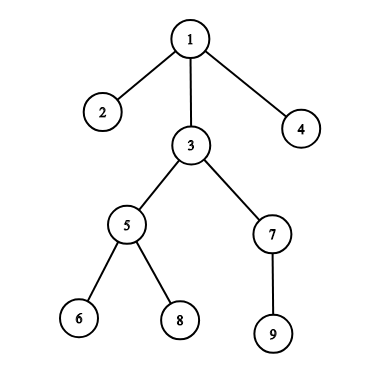E. Military Problem(大水题)
Time Limit 3s
Memory Limit 256M
-
原题
In this problem you will have to help Berland army with organizing their command delivery system.
There are n officers in Berland army. The first officer is the commander of the army, and he does not have any superiors. Every other officer has exactly one direct superior(上级). If officer a is the direct superior of officer b, then we also can say that officer b is a direct subordinate(下级) of officer a.
Officer x is considered to be a subordinate (direct or indirect) of officer y if one of the following conditions holds:
- officer y is the direct superior of officer x;
- the direct superior of officer x is a subordinate of officer y.
For example, on the picture below the subordinates of the officer 3 are: 5,6,7,8,9.
The structure of Berland army is organized in such a way that every officer, except for the commander(司令), is a subordinate of the commander of the army.
Formally(正式地), let's represent Berland army as a tree consisting of n vertices, in which vertex u corresponds to officer u. The parent of vertex u corresponds to(与...相符) the direct superior of officer u. The root (which has index 1) corresponds to the commander of the army.
Berland War Ministry has ordered you to give answers on q queries, the i-th query is given as (ui,ki), where ui is some officer, and ki is a positive integer.
To process the i-th query imagine how a command from ui spreads to the subordinates of ui. Typical DFS (depth first search) algorithm is used here.
Suppose the current officer is a and he spreads a command. Officer a chooses b — one of his direct subordinates (i.e. a child in the tree) who has not received this command yet. If there are many such direct subordinates, then a chooses the one having minimal index. Officer a gives a command to officer b. Afterwards, b uses exactly the same algorithm to spread the command to its subtree. After b finishes spreading the command, officer a chooses the next direct subordinate again (using the same strategy(方法)). When officer a cannot choose any direct subordinate who still hasn't received this command, officer a finishes spreading the command.
Let's look at the following example:

If officer 1 spreads a command, officers receive it in the following order: [1,2,3,5,6,8,7,9,4].
If officer 3 spreads a command, officers receive it in the following order: [3,5,6,8,7,9].
If officer 7 spreads a command, officers receive it in the following order: [7,9].
If officer 9 spreads a command, officers receive it in the following order: [9].
To answer the i-th query (ui,ki), construct a sequence which describes the order in which officers will receive the command if the ui-th officer spreads it. Return the ki-th element of the constructed list or -1 if there are fewer than ki elements in it.
You should process queries independently. A query doesn't affect the following queries.
Input
The first line of the input contains two integers n and q (2≤n≤2⋅105,1≤q≤2⋅105) — the number of officers in Berland army and the number of queries.
The second line of the input contains n−1 integers p2,p3,…,pn(1≤pi<i), where pi is the index of the direct superior of the officer having the index i. The commander has index 1 and doesn't have any superiors.
The next q lines describe the queries. The i-th query is given as a pair (ui,ki) (1≤ui,ki≤n), where ui is the index of the officer which starts spreading a command, and ki is the index of the required officer in the command spreading sequence(序列).
Output
Print q numbers, where the i-th number is the officer at the position ki in the list which describes the order in which officers will receive the command if it starts spreading from officer ui. Print "-1" if the number of officers which receive the command is less than ki.
You should process queries independently. They do not affect each other.
Example Input
9 6
1 1 1 3 5 3 5 7
3 1
1 5
3 4
7 3
1 8
1 9
Example Output
3
6
8
-1
9
4
-
题意
好久不学英语,本蒟蒻竟然看了好久的题目。。。
题意很简单,给你一棵n个节点的树,q个询问u先序遍历后面的第k个点
-
Solution
(写这篇blog纯属因为自己very stupid地T了一次)
-
Code(TLE)
#include <cstdio>
#include <vector>
#define N 200010
using namespace std;
int fa[N], size[N];
vector <int> son[N];
void dfs1(int x) {
size[x] = 1;
vector <int> :: iterator it;
for (it = son[x].begin(); it != son[x].end(); it++) {
dfs1(*it);
size[x] += size[*it];
}
}
void dfs2(int x, int o) {
if (o == 1) {
printf("%d\n", x);
return;
}
o--;
vector <int> :: iterator it = son[x].begin();
while (o > size[*it]) {
o -= size[*it];
it++;
}
dfs2(*it, o);
}
int main() {
int n, q;
scanf("%d%d", &n, &q);
for (int i = 2; i <= n; ++i) {
scanf("%d", &fa[i]);
son[fa[i]].push_back(i);
}
dfs1(1);
while (q--) {
int u, k;
scanf("%d%d", &u, &k);
if (k > size[u]) {
printf("-1\n");
continue;
}
dfs2(u, k);
}
return 0;
}-
Code(AC)
#include <cstdio>
#include <vector>
#define N 200010
using namespace std;
int fa[N], size[N], qu[N], pu[N], cnt;
vector <int> son[N];
void dfs1(int x) {
qu[++cnt] = x;
pu[x] = cnt;
size[x] = 1;
vector <int> :: iterator it;
for (it = son[x].begin(); it != son[x].end(); it++) {
dfs1(*it);
size[x] += size[*it];
}
}
int main() {
int n, q;
scanf("%d%d", &n, &q);
for (int i = 2; i <= n; ++i) {
scanf("%d", &fa[i]);
son[fa[i]].push_back(i);
}
dfs1(1);
while (q--) {
int u, k;
scanf("%d%d", &u, &k);
if (k > size[u]) {
printf("-1\n");
continue;
}
printf("%d\n", qu[pu[u] + k - 1]);
}
return 0;
}